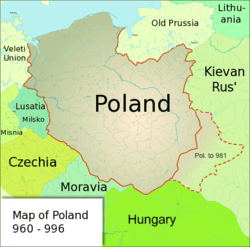Civitas Schinesghe
Civitas Schinesghe (Ecclesiastical Latin: [ˈtʃivitas skiˈnesɡe]) is the first recorded name related to Poland as a political entity (the name is a Latinization of hrady knezske or grody książęce, "ducal forts/oppidia")[1] first attested in 991/2. The original deed is missing, but is mentioned in an 11th-century papal regesta called Dagome iudex. It states that the Piast duke wife Oda von Haldensleben had given the guidance of unam civitatem in integro, que vocatur Schinesghe ("a whole state, which is called Schinesghe") over to the Holy See.
Civitas Schinesghe | |||||||||||||||||
|---|---|---|---|---|---|---|---|---|---|---|---|---|---|---|---|---|---|
| 9th century–1025 | |||||||||||||||||
 Emblem of
Bolesław I the Brave | |||||||||||||||||
 Poland within Europe around 1000CE | |||||||||||||||||
 Poland during 960-996. | |||||||||||||||||
| Capital | Gniezno | ||||||||||||||||
| Common languages | Polish (Old Polish) | ||||||||||||||||
| Religion | Slavic paganism, Roman Catholicism (institutional since 966) | ||||||||||||||||
| Government | Monarchy | ||||||||||||||||
| Monarch | |||||||||||||||||
• d. 861 | Piast Kołodziej first | ||||||||||||||||
• 960–992 | Mieszko I | ||||||||||||||||
• 992–1025 | Bolesław I Chrobry last | ||||||||||||||||
| History | |||||||||||||||||
• Established | 9th century | ||||||||||||||||
• Coronation of Bolesław I the Brave | 1025 | ||||||||||||||||
| ISO 3166 code | PL | ||||||||||||||||
| |||||||||||||||||
Though a state of Poland is not explicitly mentioned, the name Schinesghe most likely refers to Gniezno, one of the main settlements of the West Slavic Polans. Their duke Mieszko had himself baptised upon his marriage to Princess Dobrawa of Bohemia in 965. In 1000 at the Congress of Gniezno the first Polish archdiocese was established and Mieszko's son Duke Bolesław I Chrobry was acknowledged as frater et cooperator of the Holy Roman Empire by Emperor Otto III.
Borders under Mieszko I

Analysis of the document can help reconstruct the borders of the Polish realm:[2]
- sicuti incipit a primo latere longum mare, "as it starts from the first side of a long sea" (presumably the Pomeranian coast - on the Baltic Sea)
- fine Bruzze 'end Bruzze' - "along the Prussian borders" (settlement area of the Old Prussians)
- usque in locum, qui dicitur Russe - "up to a place called Rus'" (east of Masovia)
- et fines Russe extendente usque in Craccoa - "Russia ends and extending into Cracow"
- et ab ipsa Craccoa usque ad flumen Odde recte - "and from there right along the Oder river"
- in locum, qui dicitur Alemure, "in a place called The Alemure" (sometimes identified as Olomouc in Moravia though Olomouc is upriver on the Oder, not down)
- et ab ipsa Alemura usque in terram Milze recte intra Oddere - "to the Milceni lands" (part of the Imperial Margraviate of Meissen)
- et exinde ducente iuxta flumen Oddera usque in predictam civitate Schinesghe. - "and from its borders along the Oder to aforementioned Schinesghe."
The last statement suggests that Schinesghe is on the Oder and on the Baltic coast and becomes clear only after reversing "sch" to "chs" giving clearly understandable Chsinesghe which is "książęce" in modern Polish, so "civitate Schinesghe" reads as "the cities of the Duke".
Notes
- According to Brygida Kürbis, the initial "Sc" is mistakenly recorded from "K". The original record would read so "Kninesne" or "Khinesghe" Dowiat, Jerzy (1961). Metryka chrztu Mieszka I i jej geneza. Warszawa. p. 91.
- Kürbis, B. Dagome iudex. Studium krytyczne. pp. 362–423.
References
- Kürbis, Brygida (1962). Dagome iudex. Studium krytyczne [in:] Początki państwa polskiego – Księga Tysiąclecia vol. 2. Poznań.
- Piskorski, Jan Maria (August 2004). Civitas Schinesghe. Mieszko I i początki państwa polskiego. Poznańskie Towarzystwo Przyjaciół Nauk. ISBN 83-7063-416-8.